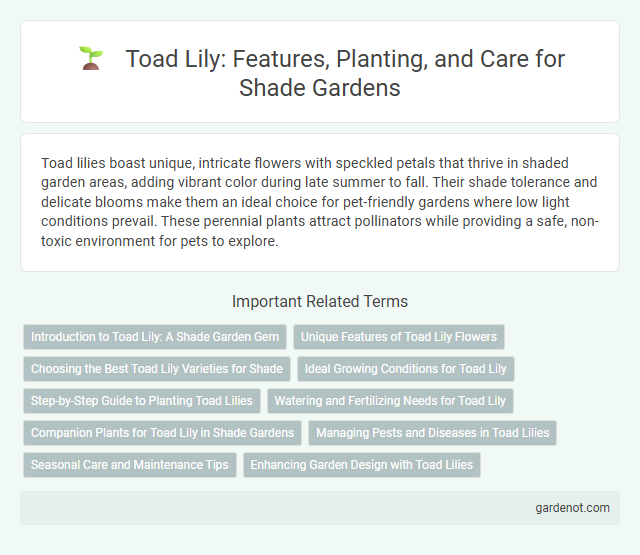Toad lilies boast unique, intricate flowers with speckled petals that thrive in shaded garden areas, adding vibrant color during late summer to fall. Their shade tolerance and delicate blooms make them an ideal choice for pet-friendly gardens where low light conditions prevail. These perennial plants attract pollinators while providing a safe, non-toxic environment for pets to explore.
Introduction to Toad Lily: A Shade Garden Gem
Toad lily (Tricyrtis) thrives in shade gardens, offering exotic, orchid-like blooms in late summer and fall, perfect for brightening dark corners. Its intricate, speckled flowers attract pollinators such as bees and butterflies, enhancing biodiversity. Native to Asia, this perennial is resilient to low light and prefers moist, well-drained soil, making it a standout choice for shady landscapes.
Unique Features of Toad Lily Flowers
Toad lily flowers showcase intricate, orchid-like blooms with striking speckled patterns, offering a unique visual appeal in shaded garden areas. Their blooms typically emerge in late summer to fall, providing vital color when many other shade plants have finished flowering. These flowers thrive in moist, well-drained soil and attract pollinators such as bees and hummingbirds, enhancing the biodiversity of shade gardens.
Choosing the Best Toad Lily Varieties for Shade
Toad lilies (Tricyrtis) thrive in shaded gardens, prized for their exotic, orchid-like flowers that bloom in late summer to fall. Selecting the best varieties such as 'Mist Maiden', 'Kaga Nishiki', and 'Purple Love' ensures vibrant color, disease resistance, and compact growth suitable for diverse shade conditions. These shade-tolerant perennials require well-drained, humus-rich soil and consistent moisture to maximize bloom quality and garden impact.
Ideal Growing Conditions for Toad Lily
Toad lilies thrive in well-drained, moist soil enriched with organic matter, preferring partial to full shade environments that mimic their native woodland habitats. These perennial plants require consistently cool temperatures and protection from harsh sunlight to prevent leaf scorching and promote vibrant, orchid-like blooms. Ideal growing conditions include a soil pH between 6.0 and 7.0, along with adequate mulch to retain moisture and support root health throughout the growing season.
Step-by-Step Guide to Planting Toad Lilies
Toad lilies thrive best in shaded, moist, well-drained soil enriched with organic matter. Begin by selecting a location with partial to full shade, then dig holes twice the width of the root ball and plant bulbs at a depth of about 2 inches. Water thoroughly after planting, maintain consistent moisture, and apply mulch to retain soil moisture and suppress weeds.
Watering and Fertilizing Needs for Toad Lily
Toad lilies thrive in consistently moist, well-drained soil, requiring regular watering to maintain optimal growth, especially during dry spells. They prefer a balanced, slow-release fertilizer applied in early spring and mid-summer to support their delicate blooms and lush foliage. Ensuring proper hydration and nutrient supply enhances their resilience and vibrant floral display in shade gardens.
Companion Plants for Toad Lily in Shade Gardens
Toad lilies (Tricyrtis spp.) thrive in shade gardens alongside companion plants like ferns, hostas, and astilbes, which complement their speckled flowers and enhance texture contrast. These companion plants prefer similar moisture and soil conditions, supporting a cohesive, low-light environment. Integrating bleeding hearts and Solomon's seal further enriches the shade garden's diversity while maintaining the delicate balance needed for toad lily growth.
Managing Pests and Diseases in Toad Lilies
Toad lilies (Tricyrtis spp.) thrive in shaded garden environments but require vigilant pest and disease management to maintain healthy growth. Common pests such as slugs and aphids can be controlled with organic insecticides or natural predators like ladybugs, while fungal diseases including powdery mildew and leaf spot benefit from improved air circulation and fungicidal treatments. Consistent monitoring and early intervention significantly reduce damage, ensuring vibrant blooms and resilient plants in shade gardens.
Seasonal Care and Maintenance Tips
Toad lily (Tricyrtis spp.) thrives in shaded garden areas with moist, well-drained soil, requiring consistent watering during dry spells to prevent stress and promote vibrant blooms. Mulching in early spring helps retain soil moisture and regulate temperature, while removing spent flowers and cutting back dead foliage in late fall enhances plant health and encourages vigorous growth the following season. Regularly monitoring for pests such as slugs and aphids ensures Toad lilies remain healthy and maintain their delicate, orchid-like flowers throughout the fall bloom period.
Enhancing Garden Design with Toad Lilies
Toad lilies (Tricyrtis spp.) bring unique visual interest to shade gardens with their orchid-like, speckled flowers that bloom late in the season, extending garden color into fall. Their ability to thrive in low-light conditions and moist, well-drained soil makes them ideal for shaded garden beds and woodland settings. Incorporating toad lilies enhances garden texture and diversity, attracting pollinators while complementing ferns and hostas for layered, dynamic landscaping.
Toad lily feature Infographic

 gardenot.com
gardenot.com